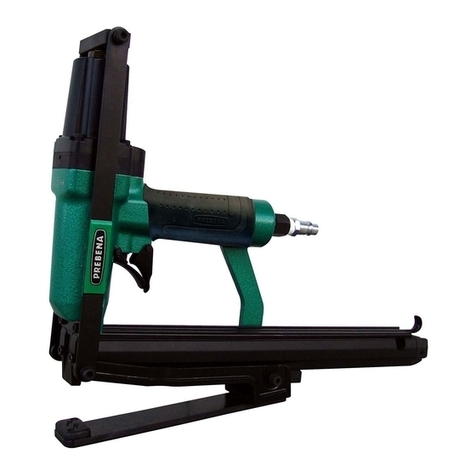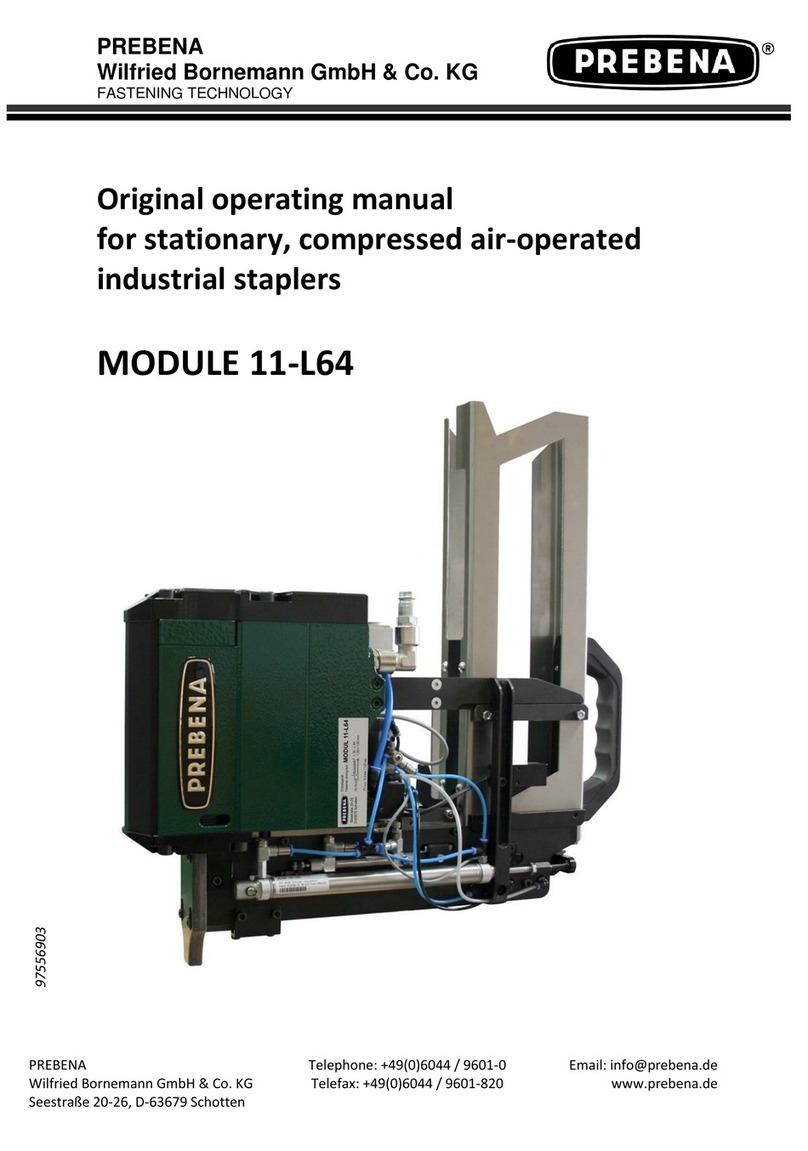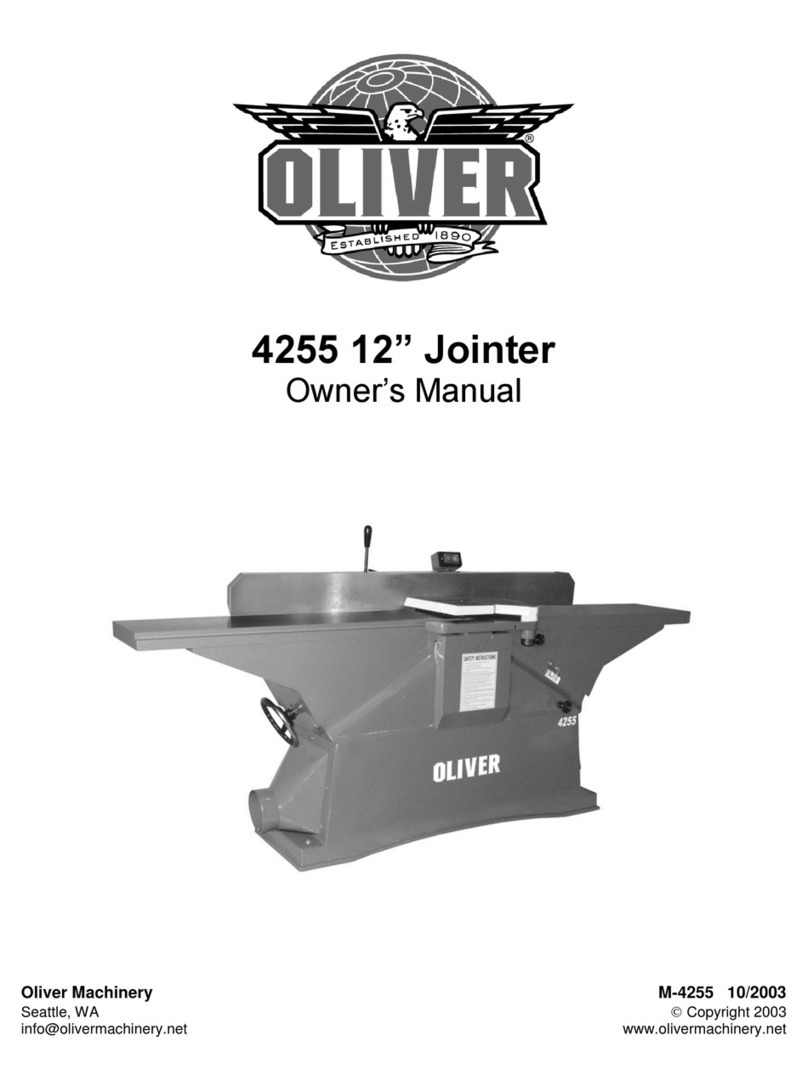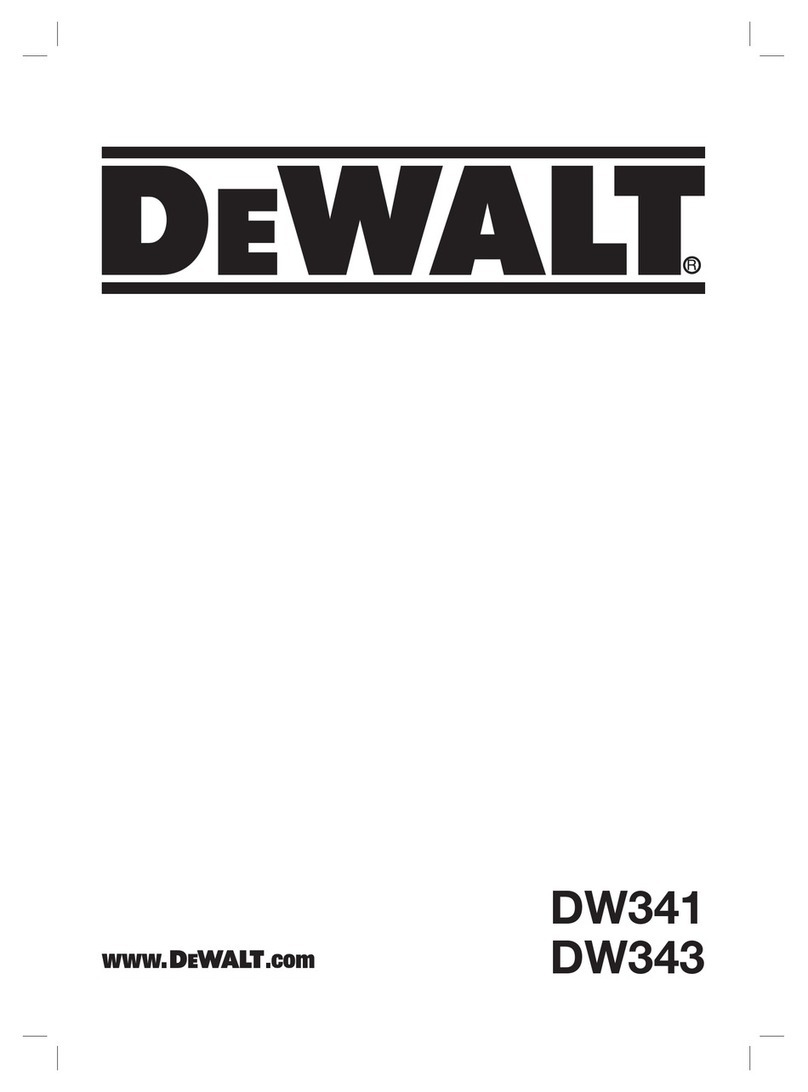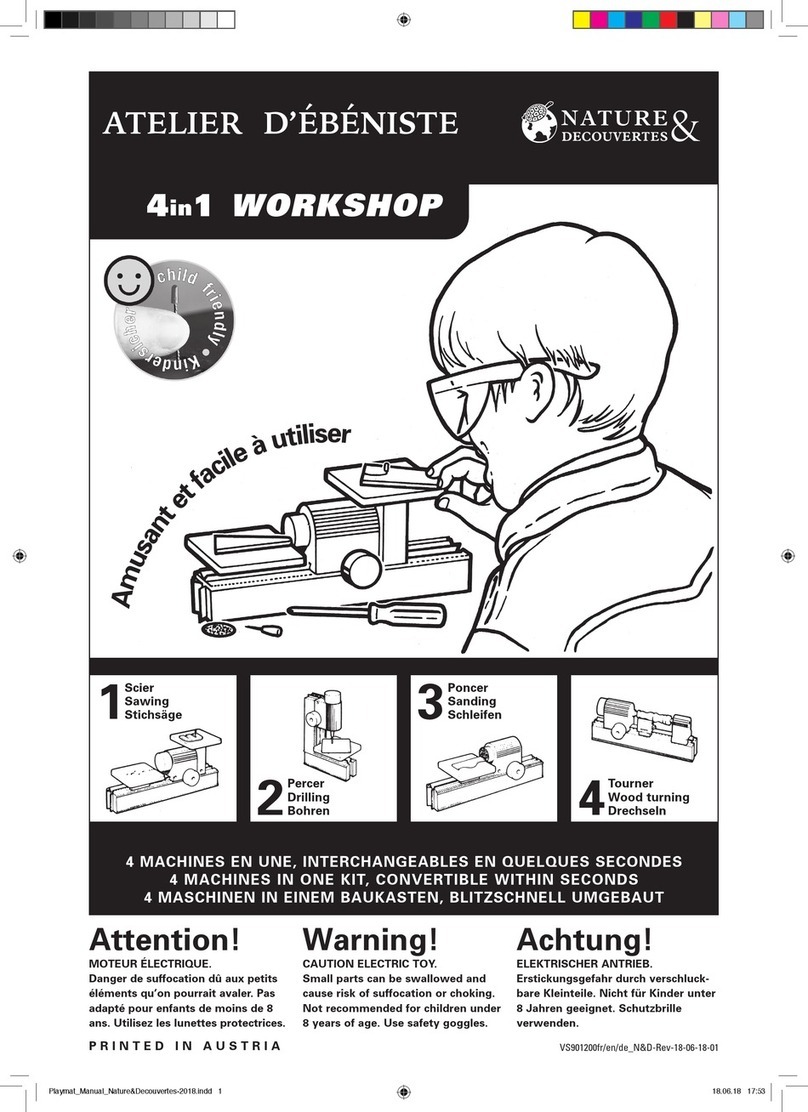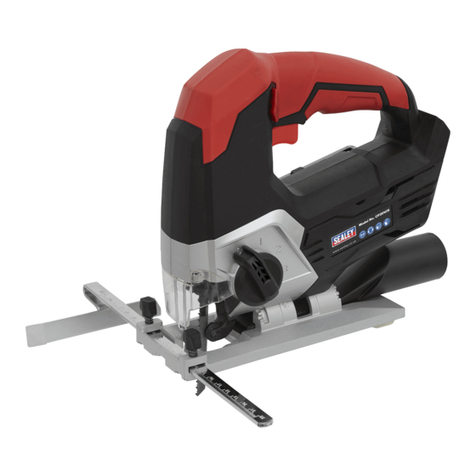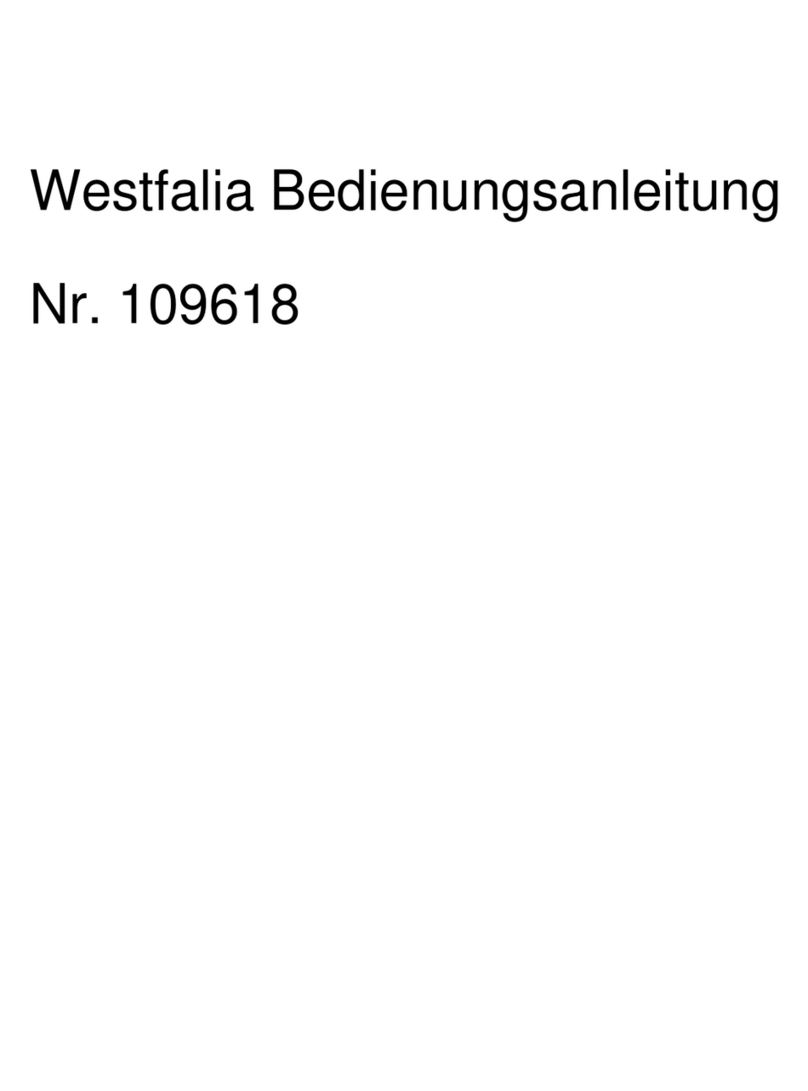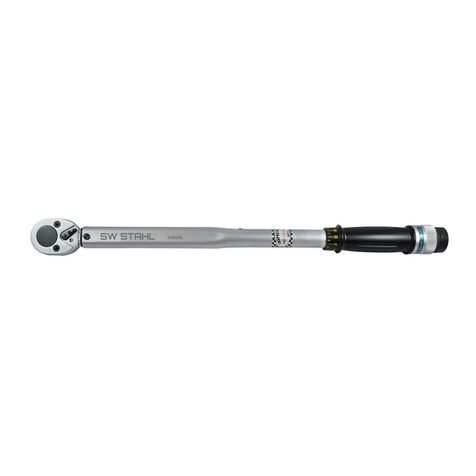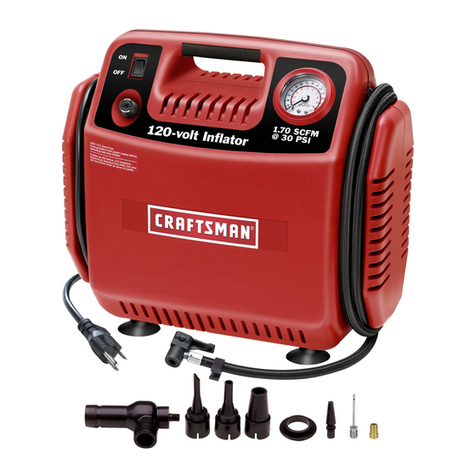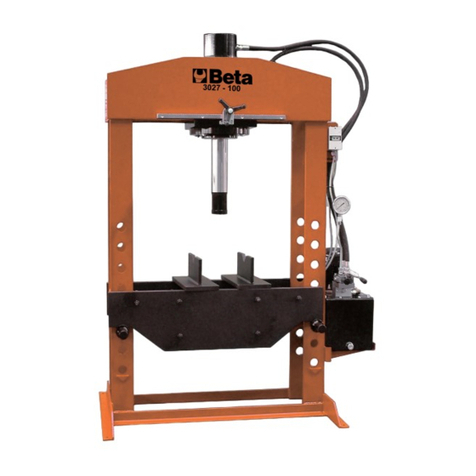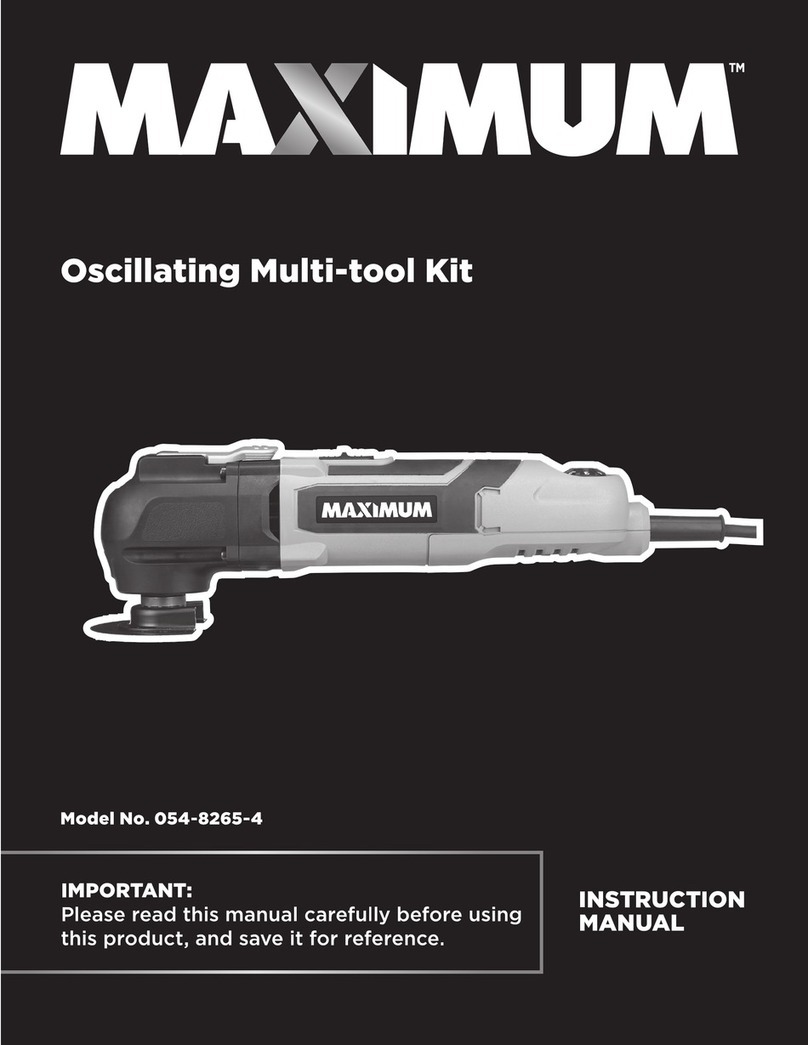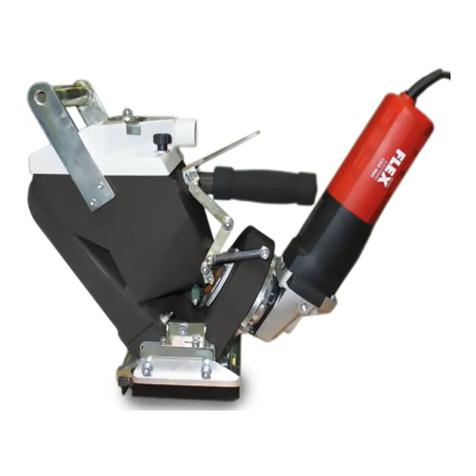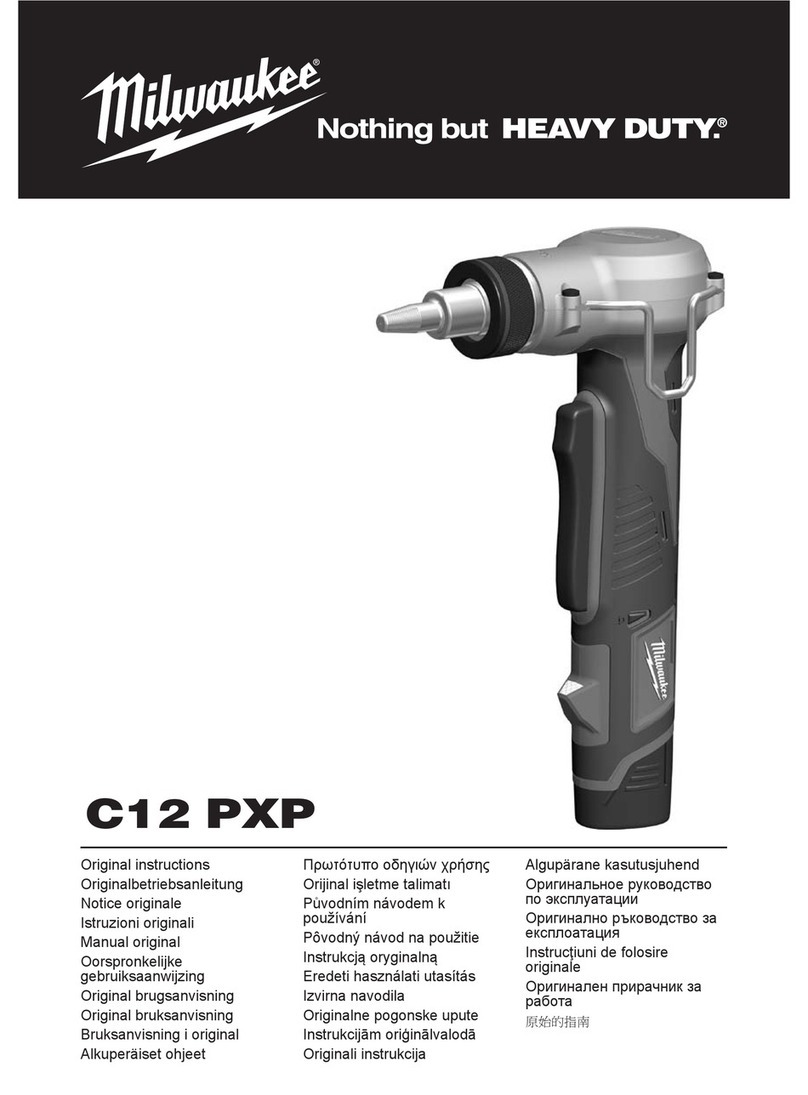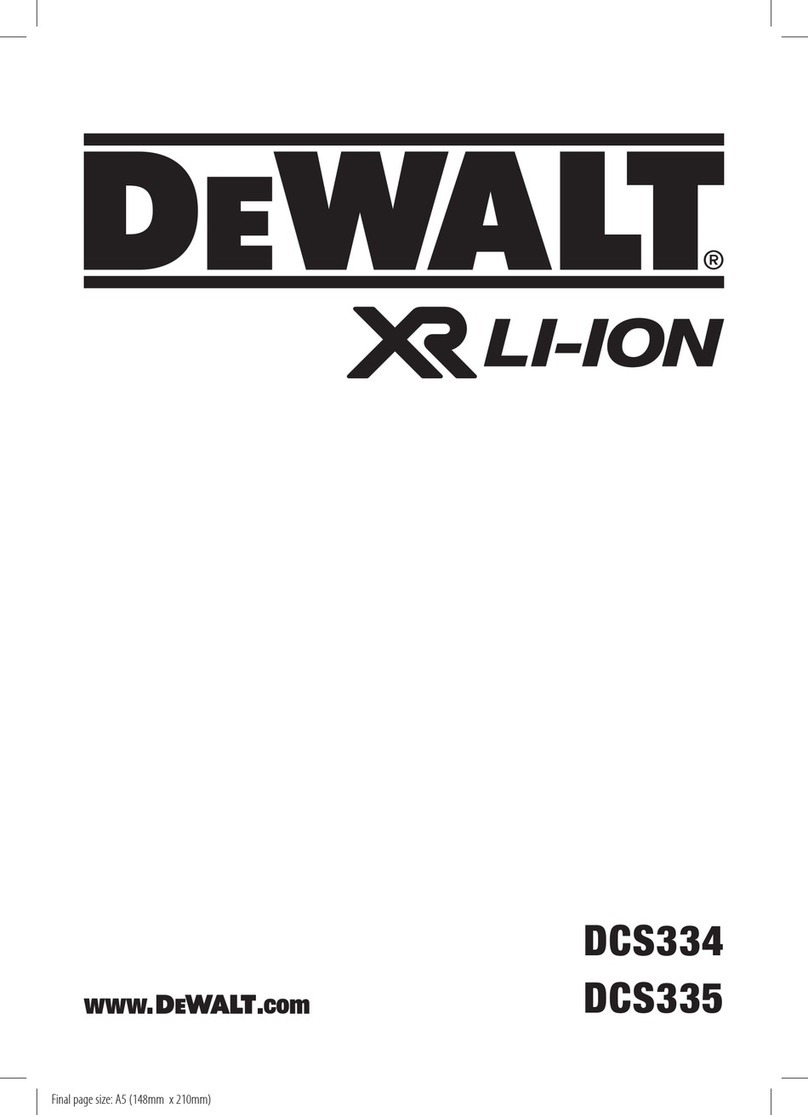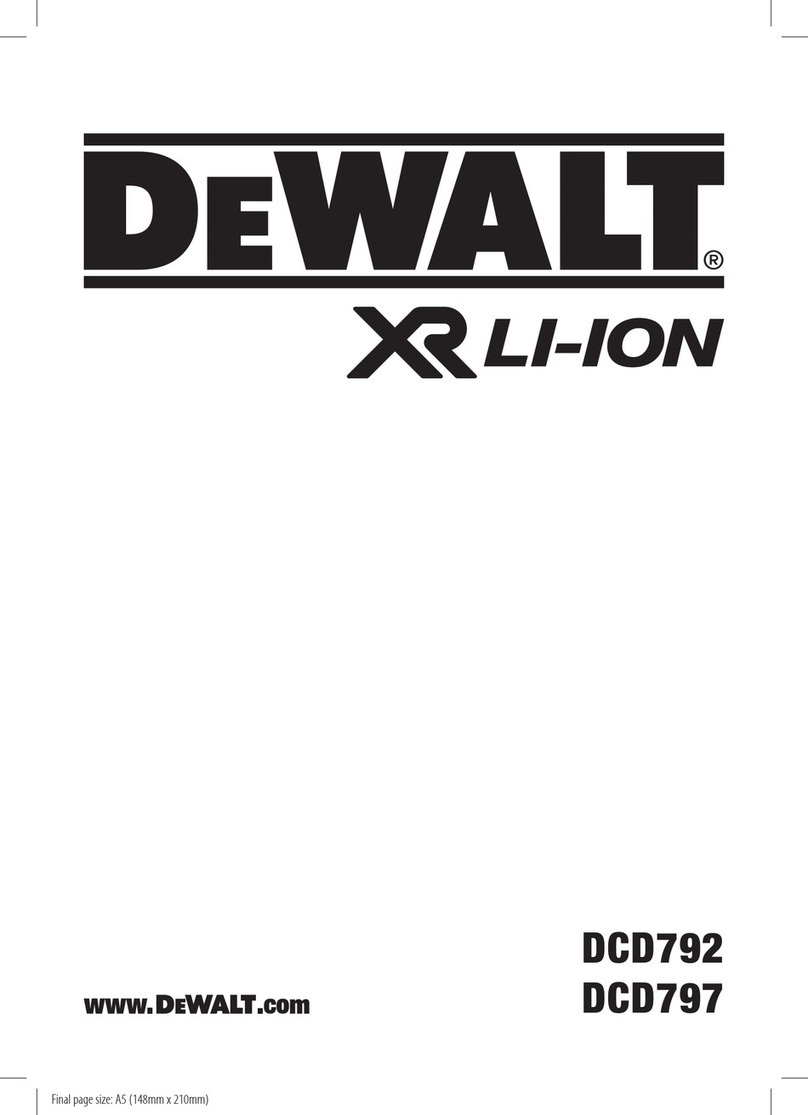Prebena PKT-7-RK90 Installation instructions

PREBENA Wilfried Bornemann GmbH & Co. KG
Seestraße 20 – 26, 63679 Schotten, Germany
Tel.: +49 (0) 60 44 / 96 01 – 0, Fax: +49 (0) 60 44 / 96 01 – 80
eMail: info@prebena.com
www.prebena.de, www.kartuschen-tausch.de
Original Operating Manual for the
Pneumatic Tool
PREBENA PKT-7-RK90

Introduction
This operating manual is an aid for
•proper,
•safe, and
•advantageous
use of the pneumatic tool, PKT-7-RK90 and PKT-7-RK90-S.
We assume that every user of the pneumatic tool has experience
handling devices that are powered by compressed air, and
experience with the materials used. Those who do not have this
experience must be instructed in the operation of the pneumatic tool.
Every person who
operates,
cleans, or
disposes of
this pneumatic tool must have read and understood this operating
manual.
This operating manual is considered as a component of the product.
Always keep this operating with the pneumatic tool. If you sell the
pneumatic tool, or provide it to another party, ensure that the
operating manual is included with the pneumatic tool.

Table of Contents
Organizational Features.................................................................. 5
General Organizational Features ................................................. 5
Features of the safety instructions ............................................... 6
Basic safety instructions ...................................................... 7
Proper Use ................................................................................... 7
Hazard - avoid fatal injuries.......................................................... 8
Avoid explosion hazards .............................................................. 8
Avoid injury hazards ..................................................................... 8
Avoid damage to the pneumatic tool............................................ 9
Description ..................................................................................... 10
Device overview and scope of delivery ...................................... 10
Function...................................................................................... 12
Product features ......................................................................... 12
Left/right and direction information............................................. 12
Safety fixtures............................................................................. 13
Accessories ................................................................................ 15
Rating plate information ............................................................. 15
Preparing the pneumatic tool....................................................... 16
Unpacking the pneumatic tool .................................................... 16
Check the condition.................................................................... 17
Connecting the pneumatic tool to the compressed air supply ... 18
Filling the magazine ................................................................... 25
Adjust the air discharge.............................................................. 27
Check the function...................................................................... 28
Operating the pneumatic tool ...................................................... 29

Selecting the release setting ......................................................29
Adjusting depth-of-drive..............................................................31
Driving nails ................................................................................34
Interrupting operation .................................................................38
Reloading the magazine (lock-out safety device).......................39
After operation ...............................................................................40
Disconnecting the compressed air supply..................................40
Emptying the magazine ..............................................................41
Transporting and storing the pneumatic tool.............................43
Packing .......................................................................................43
Transport ....................................................................................45
Storage .......................................................................................46
Maintaining the pneumatic tool....................................................47
Cleaning the housing and exterior surfaces...............................47
Lubricating the pneumatic tool....................................................48
Charging compressed air cartridges ..........................................49
Test the compressed air cartridge..............................................49
Troubleshooting ............................................................................50
Ordering accessories .................................................................... 54
Ordering nails .............................................................................54
Ordering additional compressed air cartridges...........................54
Ordering other accessories ........................................................55
Pneumatic tool disposal ...............................................................56
Technical data................................................................................57
Pneumatic tool PKT-7-RK90 ......................................................57
KT-3500 compressed air cartridge .............................................57
Manufacturer's address ................................................................58
Guarantee .......................................................................................59
Index................................................................................................60

Organizational Features
5
Organizational Features
General Organizational Features
Different elements of the operating manual have specific
organizational features. These features make it easy to differentiate
normal text,Text,
listings, or
action steps.
These instructions contain additional information, such as
special tips on economical use of the pneumatic tool.

Organizational Features
6
Features of the safety instructions
All safety instructions contained in this operating manual are
structured on the same pattern. To the left there is a symbol that
indicates the type of hazard. To the right a signal word that indicates
the seriousness of the hazard. Below there is a description of the
hazard source and instructions on how you can avoid this hazard.
HAZARD
Instructions with the word HAZARD warn of
hazards that directly result in serious or fatal
injuries.
WARNING
Instructions with the word WARNING warn of
hazards that could possibly result in serious or
fatal injuries.
CAUTION
Instructions with the word CAUTION warn of
hazards in which light to medium severity
injuries, property damage, or damage to the
environment can possibly occur.

Basic safety instructions
7
Basic safety instructions
Comply with and heed all warnings and instructions in this operating
manual and on the pneumatic tool when handling the pneumatic tool.
Proper Use
The pneumatic tool is used to drive nails into wood. Using the
pneumatic tool on other materials is only permitted after consultation
with the manufacturer. Proper use also includes compliance with
accident prevention regulations and legal guidelines and standards
applicable at the site of implementation. Any other use is considered
to be improper use and can result in property damage, or even
personal injury.
Improper use particularly includes operation
by persons who have no experience operating pneumatic tools, or
no experience with the materials used,
with bypassed safety fixtures,
of pneumatic tools that have been modified without the
manufacturer's authorization,
with accessories other than those listed in this operating manual,
with compressed air sources that are not listed in this operating
manual.
in the "bump fire" release setting
-
for work that requires movement over scaffolds, stairs, ladders
or ladder-like structures,
-
for sealing crates or bins, or for attaching transport
safeguards.
PREBENA WILFRIED BORNEMANN GMBH & CO. KG assumes no
liability for damage that occurs due to improper use.

Basic safety instructions
8
Hazard - avoid fatal injuries
Never point the pneumatic tool at people, animals, or body parts.
Only release the pneumatic tool when the nose of the tool is firmly
pressed against the material.
Do not let children play with packaging; there is risk of
suffocation.
Ensure that nails are not driven into electrical lines.
Avoid explosion hazards
Do not use the pneumatic tool at locations where there is an
explosion hazard.
Never operate the pneumatic tool with oxygen or other flammable
gasses or gas mixtures.
Never expose the compressed air cartridge to temperatures in
excess of 100 °C.
Avoid injury hazards
Store the pneumatic tool where it is inaccessible to children and
other unauthorized persons.
Detach the pneumatic tool from the compressed air supply prior
to every transport.
Wear protective goggles, ear protection, and stable work clothing
when operating the pneumatic tool.
Hold the pneumatic tool in such a manner that you cannot be
injured by possible recoil.
Always adopt sure footing and a stable position when using the
pneumatic tool. Refrain particularly from operating the pneumatic
tool from a ladder or scaffold.

Basic safety instructions
9
Avoid damage to the pneumatic tool
Never open the pneumatic tool. Only have qualified specialists
perform repair work.
Do not use the pneumatic tool if it has fallen down or is damaged.
Have it checked by qualified, specialized personnel before you
operate it again.
Do not connect the pneumatic tool to a compressed air supply
that exceeds the maximum operating pressure of 8.3 bar.
Only install permanently mounted pneumatic tools in securely
anchored holding fixtures. The pneumatic tool should not turn or
shift in the holding fixture. The holder should not damage the
pneumatic tool or its accessories.

Description
10
Description
Device overview and scope of delivery

Description
11
No.
Explanation
1
Manometer for pneumatic tool operating pressure
2
Magazine block
3
Pusher
4
Magazine with nails
5
Safety device
6
Adjusting wheel of the safety device
7
Manometer for th
e pressure of the compressed air cartridge (fill
-
level
indicator
8
Safety valve for operation with the compressed air cartridge
9
Connection for the compressed air cartridge with sealing plug
10
Discharge with selector switch for the release setting
1
1
Holders for the compressed air cartridges
12
Regulator for the operating pressure
13
Connection for the pressure hose
14
Safety valve for the operating pressure with release at 10 bar
15
Housing head with thread for suspension hook
16
KT
-
3500 compre
ssed air cartridge, (only for PKT
-
7
-
RK90
-
S
17
Four Allen wrenches (sizes 3, 4, 5 and 6
18
Protective goggles
–
Metal transport case (not shown
–
Declaration of Conformity (not shown

Description
12
Function
The pneumatic tool drives single nails into a piece of wood. You can
use either a compressed air cartridge mounted on the pneumatic
tool, or a pressure hose for the compressed air supply. Excess
pressure is discharged through pressure relief valves.
You can adjust depth-of-drive by regulating the air pressure or with
the adjusting wheel for the safety device.
Product features
The pneumatic tool has the following additional features:
Operation either with compressed air cartridge or a compressed
air system,
Trigger safety with single fire or bump fire,
Lock-out safety device,
Magazine with rear-loading system,
Adjustable exhaust air discharge and
Depth adjustment.
Left/right and direction information
The left/right or direction information in this operating manual is
based on view direction towards the material.
The direction information for the compressed air regulator is based
on the view from behind looking at the operating pressure regulator.

Description
13
Safety fixtures
Safety device
The pneumatic tool has a safety device on the tool nose. Discharge
is only released when the safety device is pushed in.
WARNING
The most serious injuries are possible when
operating the pneumatic tool without a
functioning safety device.
Only use the pneumatic tool if the safety
device is functional.
Lock-out safety device
The pneumatic tool is equipped with a lock-out safety device on the
top end of the magazine. The lock-out safety device blocks the
discharge when there are fewer than three to four nails left in the
magazine.

Description
14
Warning signs attached to the pneumatic tool
The following modes of implementation are prohibited in the "bump
fire" release setting:
Work that requires movement over scaffolds, stairs, ladders, or
ladder-like structures and
using the tool to close crates or bins, as well as for attaching
transport safeguards
The respective warning symbol is affixed to the front side of the
pneumatic tool.
Three stickers are affixed next to the rating plate. These stickers
have the following meaning:
Sticker
Meaning
Wear ear protection when operating the pneumatic tool
Wear protective goggles when operating the pneumatic tool
Read the operating manual prior to operating the pneumatic
tool

Description
15
Accessories
The following accessories are available for the pneumatic tool:
KT-3500 compressed air cartridge
Compressor for compressed air cartridge PKT-FILLMASTER 350
(not included in the scope of supply)
Spiral hose with 9 mm inside diameter and 4 m work length (not
included in scope of supply)
Compressed air hose set (not included in scope of supply)
Hose drum (not included in scope of supply)
Type RK and RKP round-headed nails (see section "Ordering
nails" on page 54).
Special PREBENA nailer oil.
Rating plate information
The rating plate is affixed to the rear of the magazine. It contains the
following information:
Company name and country of origin,
type designation of the pneumatic tool
Type designation of the round head nails that can be used
Max. permissible operating pressure
CE mark (the product satisfies the standards listed in the
accompanying Declaration of Conformity)
GS mark (the product has a passed a safety inspection in
accordance with the Equipment and Product Safety Act).
Inverted triangle. (This triangle indicates that you should only
operate this device if the safety device is functional).

Preparing the pneumatic tool
16
Preparing the pneumatic tool
Unpacking the pneumatic tool
Remove the pneumatic tool from the packaging.
Remove all packaging material, such as foil, fill material, and
packing box.
WARNING
A risk of suffocation exists for children when
playing with the packaging foil.
Never permit children to play with
packaging foil.
Store packaging material where it is
inaccessible to children.
Store the packaging for later use.
Keep the transport case for transport of the pneumatic tool.
Only transport the pneumatic tool in the transport case.

Preparing the pneumatic tool
17
Check the condition
WARNING
An injury hazard exists when operating a
damaged pneumatic tool, or if accessories are
not properly mounted.
Check the condition of the pneumatic tool
prior to each use.
Only use pneumatic tools that are in
trouble-free condition.
Check the following points in particular:
-
The hose line should not be damaged.
-
All pneumatic tool parts and all accessory parts must be
securely attached.
-
The safety devices should not be blocked or otherwise
impaired in function.
-
The spring of the safety device should not be damaged.
-
There should be no external damage to any parts of the
pneumatic tool or the accessories, such as scratches or dents.
Scratches in the paint of the housing or of the magazine are
not considered damage.
Do not connect a damaged pneumatic tool to a compressed air
supply.
Have specialized personnel repair a damaged pneumatic tool
before placing it in service.

Preparing the pneumatic tool
18
Connecting the pneumatic tool to the compressed air
supply
You can connect the pneumatic tool to a compressed air system or
to compressed air cartridge.
If you connect the pneumatic tool to a compressed air system, you
can economically execute frequent driving processes at the same
location. Moreover you can feed lubricating oil into the pneumatic
tool via the compressed air system.
When you connect the pneumatic tool to a compressed air cartridge
you are independent of a stationary system.
You can connect the pneumatic tool to both sources of
compressed air at the same time. In this case the compressed
air in the cartridge will be consumed first. Then the
compressed air will be consumed from the compressed air
system.
The permissible operating pressure of the pneumatic tool is 8.3 bar.
If the permissible operating pressure is exceeded then the pointer in
the manometer for the operating pressure is in the red area.
This can occur under the following conditions:
If both safety valves are defective and
You have connected the pneumatic tool to a compressed air
system with excessive pressure, or to an unsuitable compressed
air cartridge.
WARNING
Explosion hazard when exceeding the
maximum operating pressure.
In this case disconnect the pneumatic tool
immediately from the compressed air
supply.

Preparing the pneumatic tool
19
Attaching the compressed air cartridge
Unscrew the sealing plug from the connecting thread (1.).
Check the connection and the connection thread of the
compressed air cartridge for foreign objects and fouling.
Clean the connection and the connection thread if necessary.
Check the condition of the pneumatic tool (see page 17).
WARNING
Inadvertent release can result in serious or
fatal injuries.
Do not point the pneumatic tool at people
or animals.
Empty the magazine before connecting.

Preparing the pneumatic tool
20
WARNING
Operation with unsuitable compressed air
cartridges can result in damage to the
pneumatic tool.
Only operate the pneumatic tool with type
KT-3500 compressed air cartridges.
Unscrew the sealing cap from the compressed air cartridge.
Slide the compressed air cartridge into the holders (2.).
Screw the compressed air cartridge hand-tight into the thread on
the connection element (3.).
The manometer on the connection for the compressed air cartridge
now shows the actual pressure available in the cartridge. The
pneumatic tool is ready for operation when the pointer of the
manometer is in the green area.
The manometer for the operating pressure shows the actual
operating pressure.
This manual suits for next models
1
Table of contents
Other Prebena Power Tools manuals
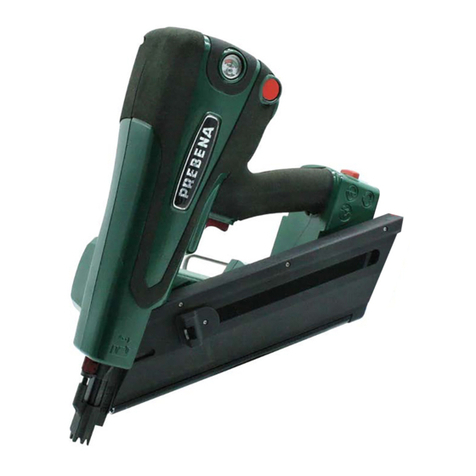
Prebena
Prebena PKT-8-PR100 Installation instructions
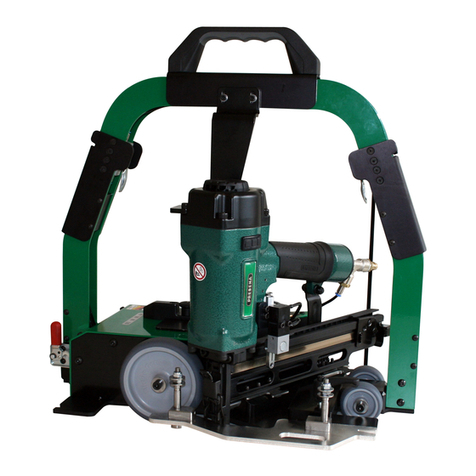
Prebena
Prebena SLIDER 4C-Z50 Quick start guide

Prebena
Prebena KTVH-B19D User manual
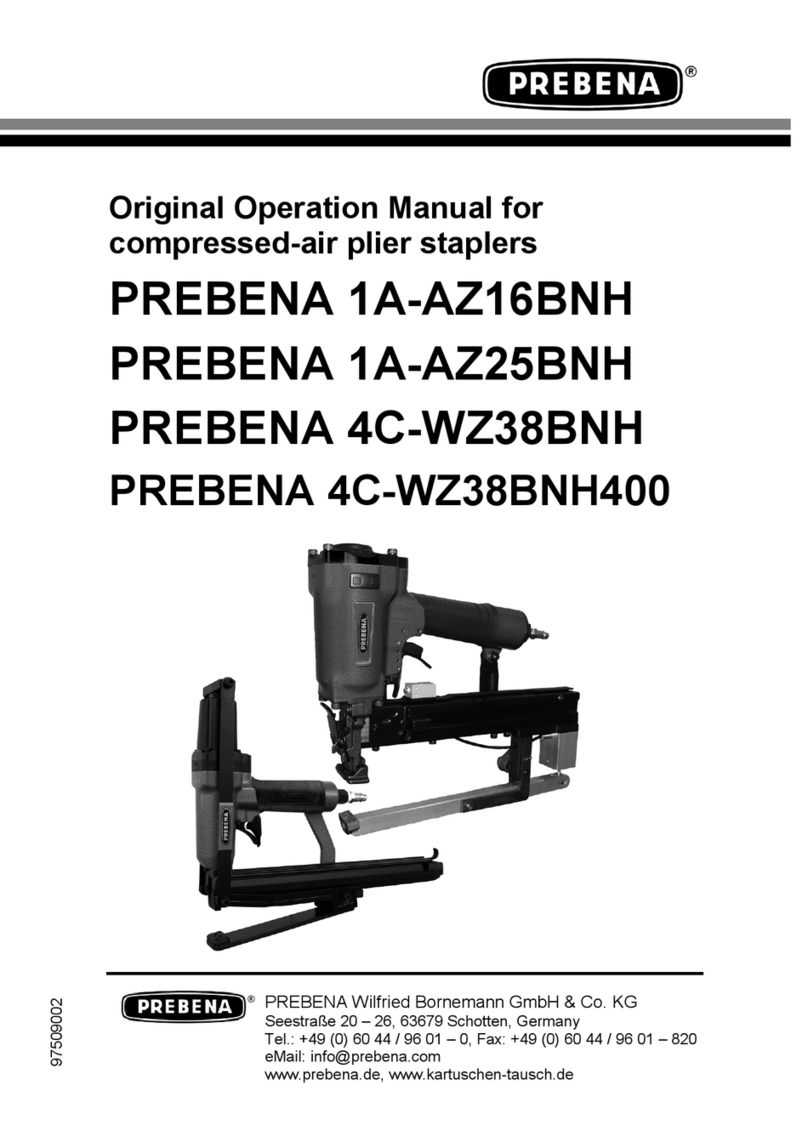
Prebena
Prebena 1A-AZ16BNH Quick start guide
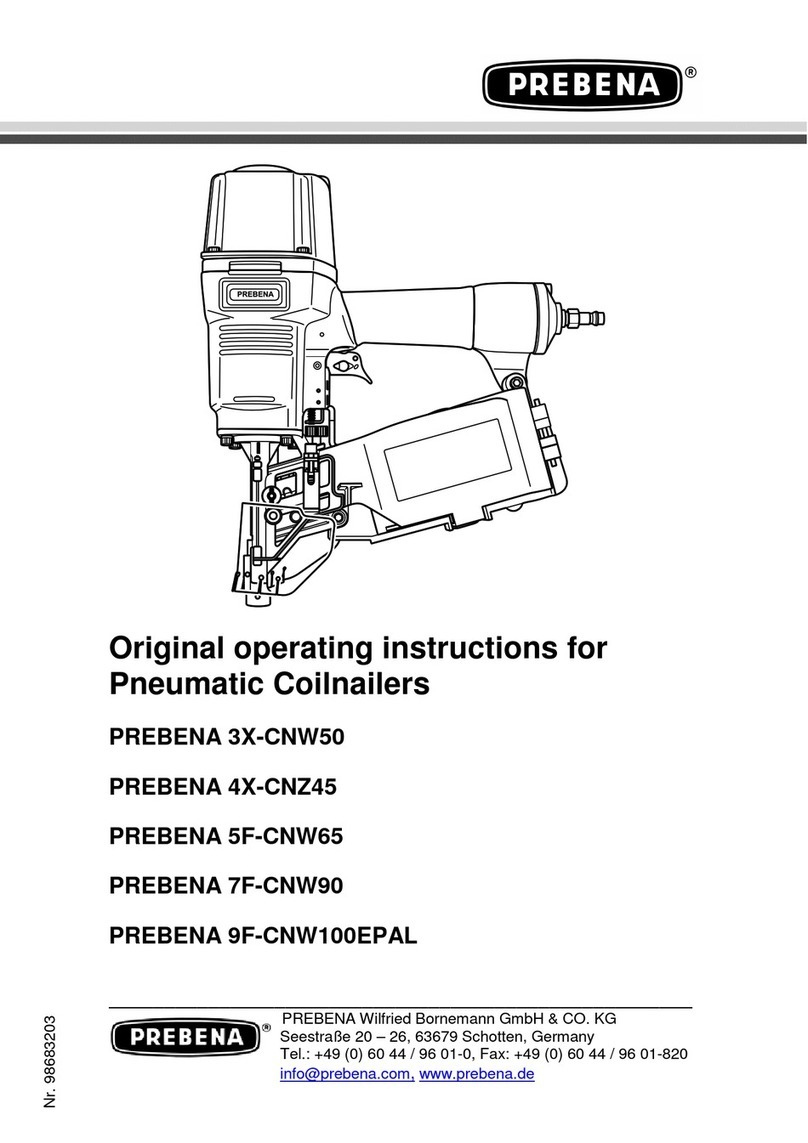
Prebena
Prebena 3X-CNW50 User manual
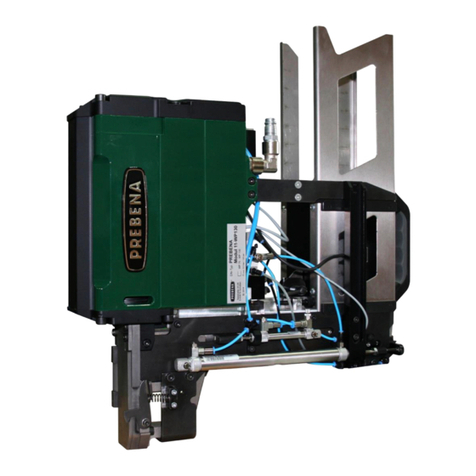
Prebena
Prebena 11-WP130 User manual
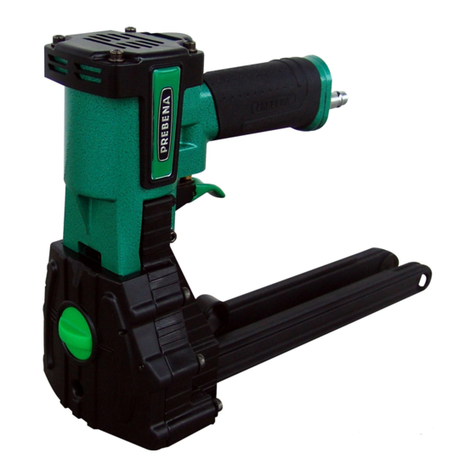
Prebena
Prebena KTVH-B19D User manual
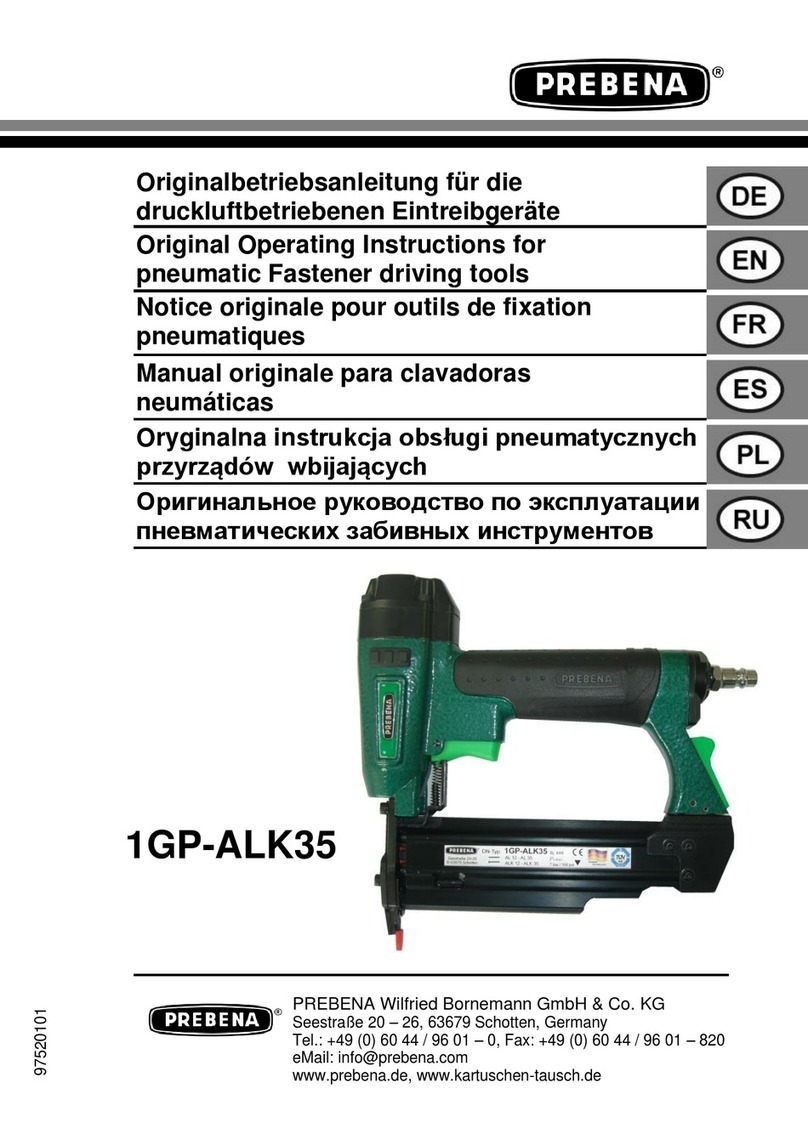
Prebena
Prebena 1GP-ALK35 User manual
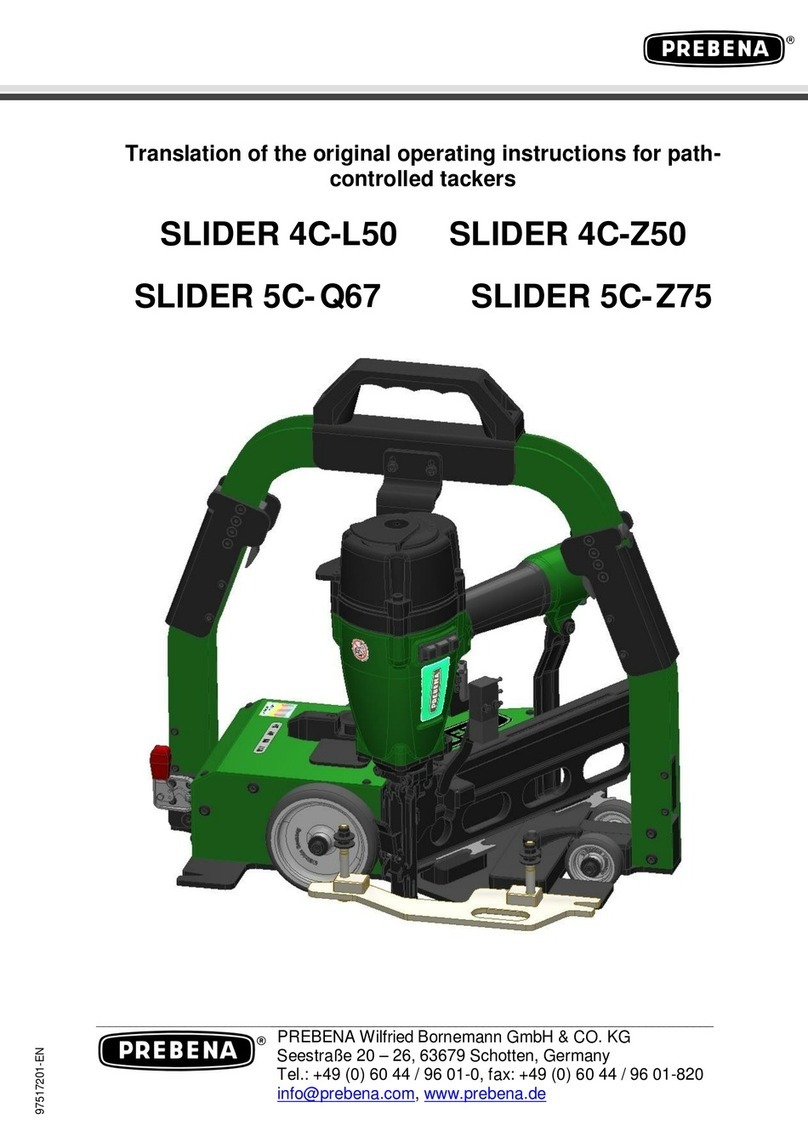
Prebena
Prebena SLIDER 4C-Z50 User manual
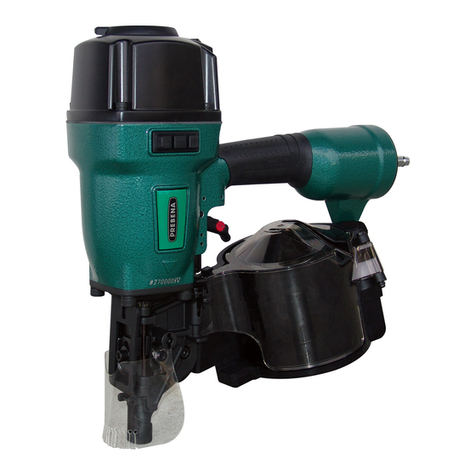
Prebena
Prebena 3X-CNW50 User manual
